Although it’s already available at retailers, I wasn’t able to get a Lenovo Duet 5 Chromebook review unit until this past weekend. Now that I have it, I’m going to use it for as much of my full-time computing as possible. I’ll share that experience after a good week of usage. For now, here are my Lenovo Duet 5 Chromebook first impressions.
In case you’re not familiar with this Chrome OS tablet, here’s a quick rundown of what it is.
I was loaned the $499 configuration available at Best Buy. The tablet has a 13.3-inch 1920 x 1080 OLED touch display with up to 400 nits of brightness. Inside is the second generation Qualcomm Snapdragon 7c compute platform paired with 8 GB of memory and
Solid, well-built hardware with nice accessories
Having just reviewed the HP Chromebook X2 11, which I thought was very well built overall, I thought it set the bar. I’d immediately say that Lenovo has either met that bar or perhaps raised it. This is a solid slate that’s only 7.23 millimeters thin, er… thick.
The display can render 100-percent of the DCI-P3 color gamut and looks fantastic. Thanks to the OLED panel, pixels representing black aren’t lit, so the contrast ratio is excellent. I watched some 1080p60 HDR videos on YouTube and they looked amazing. No, this screen isn’t HDR-capable but the brightness, color gamut, and high contrast ratio make videos look HDR-like.
Admittedly, I’m not a fan of the 16:9 aspect ratio on laptops in general. And for a tablet, I dislike it even more. The main reason: I have to scroll vertically to read content and there is often wasted space on the sides of a web page. Here’s a simple example on a 4:3 iPad Pro by comparison using the same font size in Reader Mode for the same web page:
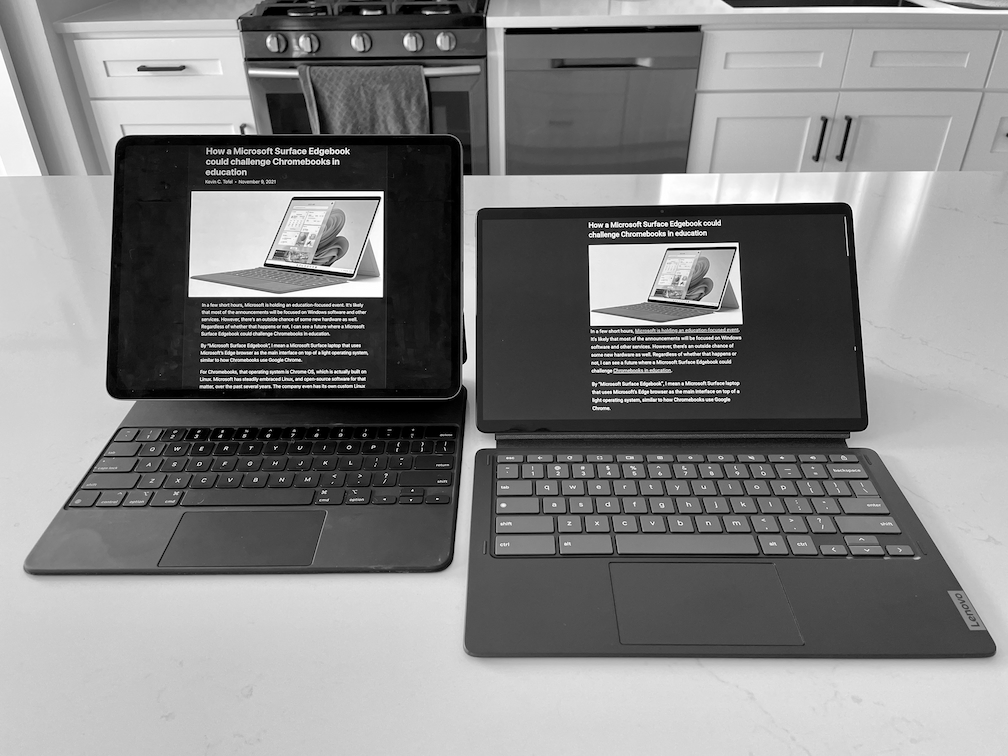
In true tablet mode, this widescreen format does have benefits though. Holding the Lenovo Duet 5 Chromebook vertically shows a ton of web content without scrolling. Anyway, that’s just me. And most of Lenovo’s recent Chromebooks use the same 16:9 ratio.
This is what the Lenovo Duet 5 Chromebook looks like compared to the Lenovo IdeaPad Chromebook 5i that I recently reviewed:
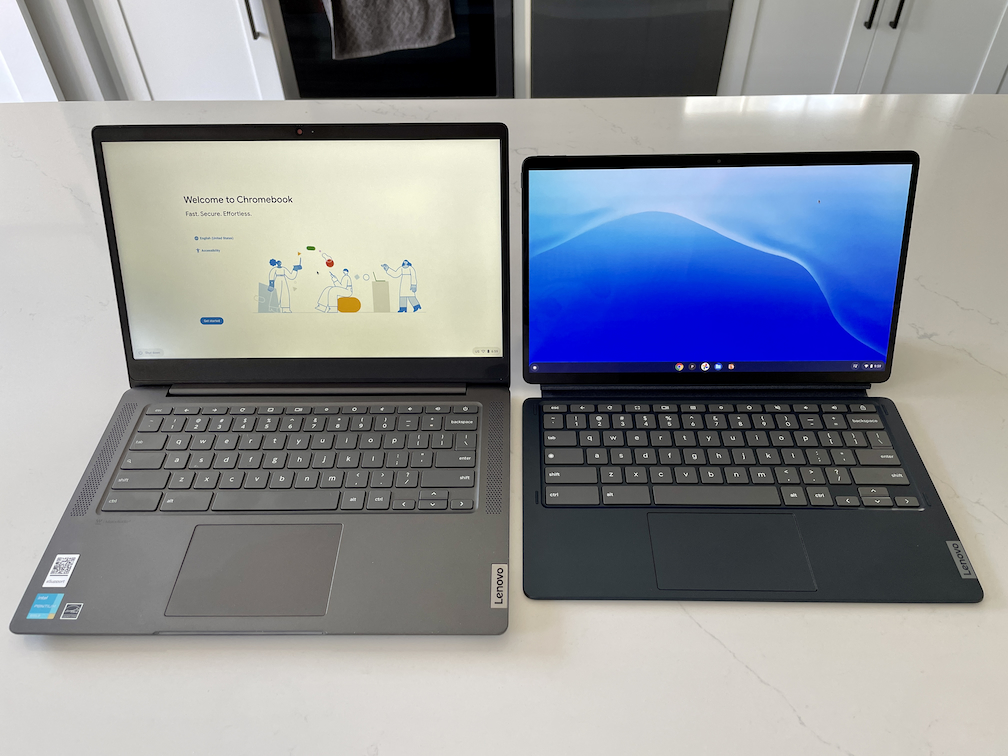
You’re getting the same screen space and nearly the same sized keyboard in the Duet 5 but in a smaller overall package and footprint
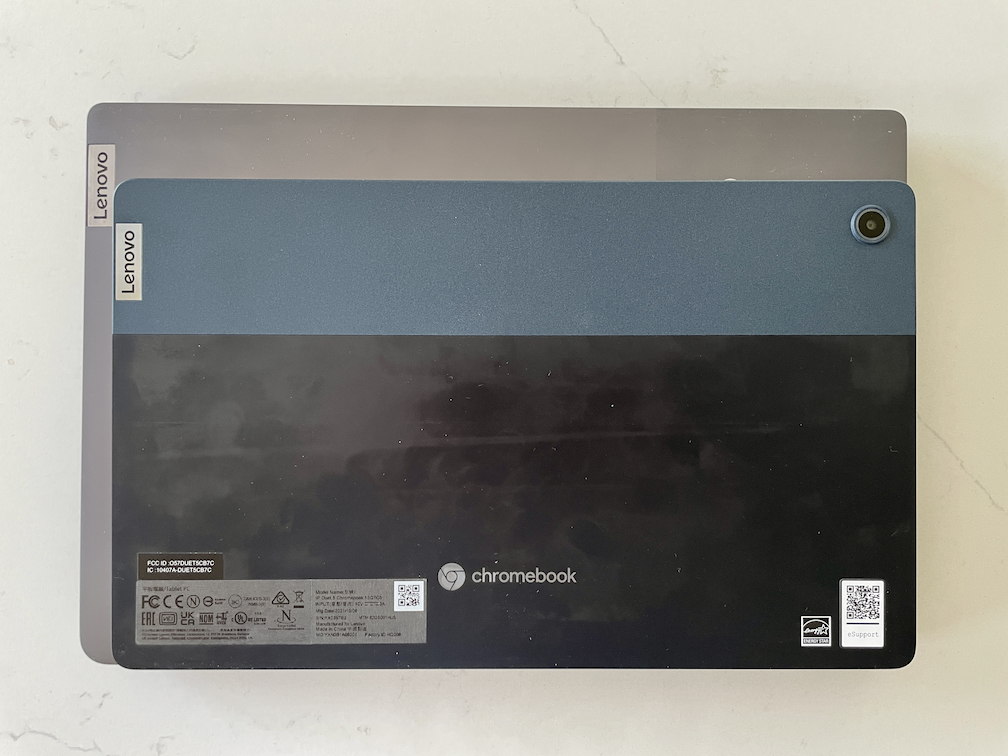
As far as the accessories go, these are quite good so far as well. The detachable keyboard has good key travel and the trackpad is responsive so far. Additionally, there’s not a lot of flex in the keyboard, so using it on a lap doesn’t introduce errant mouse clicks like the HP Chromebook X2 11 did for me.
While the keyboard attachment only connects to the slate via magnets near the metal POGO pins and not also to the display’s bottom bezel, it’s fairly stable to use on a lap. Lenovo reinforced the “hinge” with heavy-duty, stiff fabric.
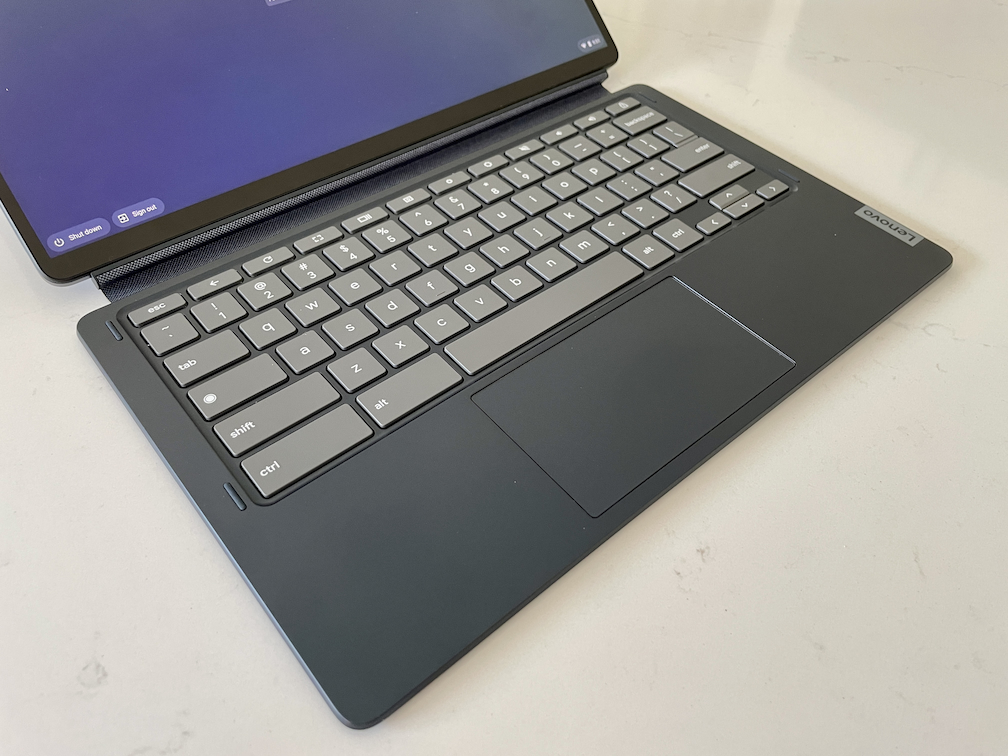
That fabric is used on the back of the keyboard and on the kickstand attachment. With the kickstand, the Lenovo Duet 5 Chromebook viewing angle can be adjusted dynamically from roughly 100-degrees to nearly flat. Oh, and I love having the web cam centered atop the display in landscape mode. Other tablet makers could take a cue from that design choice.
The same can be said for offering a pair of USB Type-C ports, one on each side. It’s nice to use either the left or right port to recharge the 42 Whr battery inside.
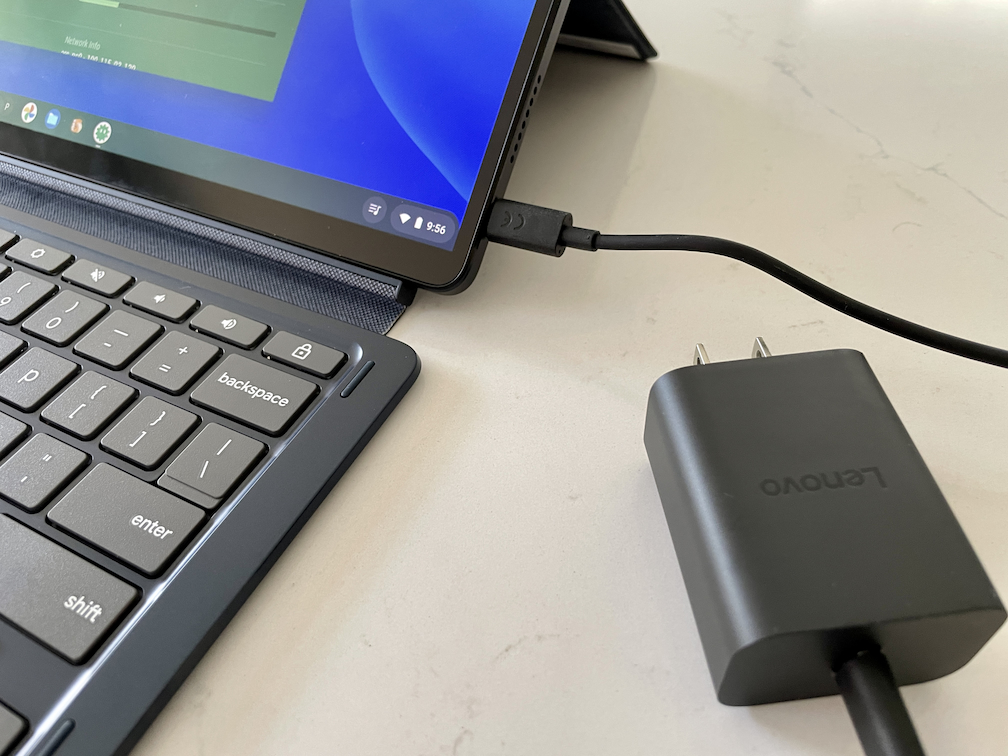
Lenovo Duet 5 Chromebook performance with that second-gen Snapdragon 7c
I haven’t run any benchmarks yet and I’ve only used this slate for a few hours. I really didn’t expect much from the next generation of the CPU and GPU inside this device. Essentially, it’s the same as the first-generation but with slightly faster clock speeds.
Even so, I have noticed a little more smoothness and snappiness during my initial browsing sessions. There are fewer instances of text stuttering and starting when scrolling down a full web page, for example, compared to the HP Chromebook X2 11. That Chrome OS tablet uses the first-generation 7c chipset. This is promising for a smartphone-based chip powering Chrome OS.
Still, you have to keep expectations in check. I’d still equate the experience to a Celeron or Pentium from a year ago or so. And that’s fine for many Chrome OS users to browse the web, use web apps and some Android apps.
I haven’t encountered any Chrome OS software bugs up to this point on the device. I’m running Chrome OS 94, which is the current Stable Channel. And with 8 GB of memory, I haven’t experienced any slowdowns either, even with around 10 tabs open. But I’ll do a deeper performance dive in my full review. And I’ll also use this device full time to get a broader experience.
I did note that Chrome OS supports the quad-speakers when it comes to rotating the volume button functionality. This code change was spotted months ago for a Chrome OS board called “Homestar”.
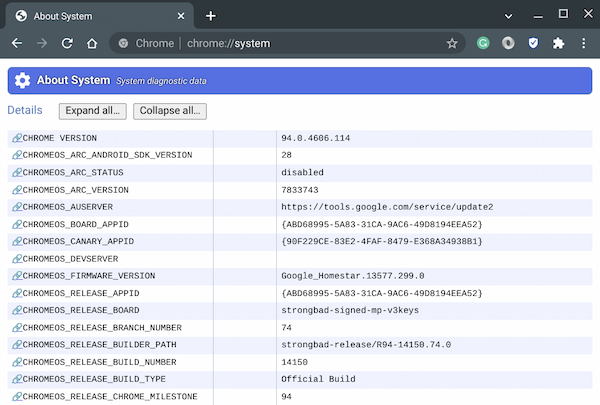
And the Lenovo Duet 5 Chromebook is indeed using that board. So when you rotate the display orientation, the volume buttons adjust for up and down levels based on that orientation. It works well, although the speakers are just one Watt and average at best so far.
So far, so good
Overall, I have favorable first impressions of the Lenovo Duet 5 Chromebook. I could see it used in a wide variety of use cases such as content consumption, game streaming, and productivity. I don’t think heavy-duty Linux users are in the mix for this Chrome OS tablet but I will try some of my coding efforts on the device.
My main questions still revolve around general performance and battery life. Lenovo claims up to 15 hours of battery life, which I think is suspect. However, if I could get a solid 10 to 11 of hours usage on a single charge, I’d say that’s good enough. I’ll also test the quick charge capabilities to see if I can get the battery from 0 to 80 percent in one hour.
If you have questions about the Lenovo Duet Chromebook 5, drop them in the comments and I’ll try to answer them along the way as I review this device.


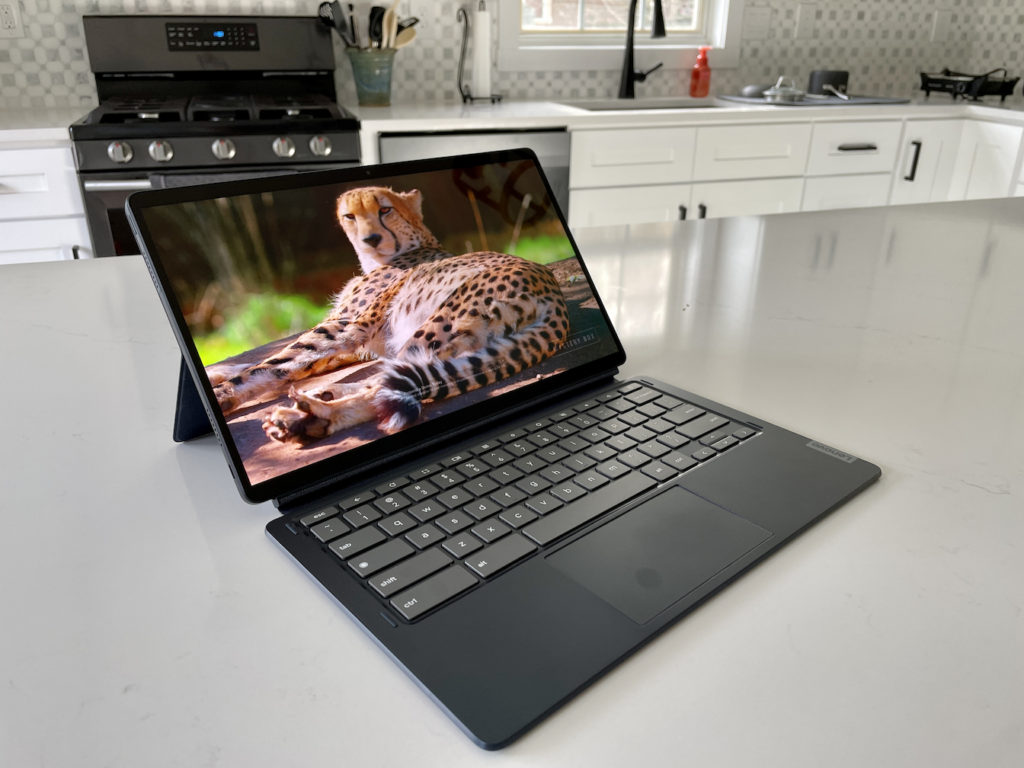
24 Comments
The 16:9 aspect ratio works well for Web pages on a laptop because so many Web sites are heavily laden with advertising on both sides of the actual content. All that advertising squeezes the content, forcing you to scroll more when you have a narrower screen.
And here I thought it was to have two usable browser views open side by side! ?
Problem is this is a Tablet, and 16:9 effectively kills portrait orientation.
Does the fabric hinge you refer to contain any wiring that would connect the keyboard to the pogo pins. I have a pixel slate and have gone through two keyboards because the flexing of the fabric hinge caused the ribbon cable to fail and I lost use of the keyboard. Google would not provide any assistance and has essentially stopped supporting this device. I’m reluctant to use another keyboard with a fabric type of hinge if it uses the same suspect technology.
I’m certain there are wires in the fabric hinge because the POGO pins between the keyboard and the display aren’t just for power. And the keyboard doesn’t use Bluetooth. I can’t speak the longevity of the design at this point, of course. It’s definitely a valid concern.
a nice review !
I normally use chrome book as a ‘thin client’ to either RDP to my laptop in office or login to a citrix farm. Have you ever tried those functions on this chromebook ? Also do you know what is the maximum resolution can the usb-c ouput if we connect it to an external monitor ? if it can support FHD, QHD or even UWQHD, that will be perfect.
regards
Which app or extension do you use for RDP?
MS Remote Desktop and citrix workforece
I’m interested in this as a primary (home user) device, both for running a couple of QHD screens to use LibreOffice & Firefox, and for marking up pdfs with a stylus. Curious how ‘natural’ the stylus experience feels with this tablet, compared to others.
I bought one of these and got a cheap usi stylus on Amazon. I haven’t used it much, but I find it very accurate and responsive for what I need. Great for selecting and sketching. Probably not the best for artists though, but for me it’s a basic productivity and consumption device for when I’m on the road
Have you compared this to last gen Chromebook Duet? It had 16:10 screen but only 4 GB RAM. However, it’s also about $200 cheaper – is the cost increase worth it with this new model?
Is a case available? Connecting and moving with the duet 4, it slipped and cracked the screen. Devil of a time finding a replacement screen. Even then the cost was equivalent to the now sale price of the duet 4. Are corners more protected on this new version?
Very curious about linux and VS Code on this, as my pixelbook slate is getting long on the tooth and has always been round about the tummy ; )
Is it just the photo or do the blacks look darker on the iPad compared to the Duet?
The first Chromebook Duet only put out a 1080p signal at 30Hz, which almost no display supports. Can this one drive an external display at a standard 1080p and 60Hz? I can’t find anybody who has plugged this thing into an external display and written about it yet. Please help?
Ditto. Trying to decide between the Surface Go 3, HP X2 11 & this tablet. Whichever I get has to be able to connect to an external monitor at full res. I know the Go 3 will but no idea about the other 2
It can do 1080p at 60hz, and 4k at 30hz
Thank you! That’s very helpful.
Please, I would love to know your impressions regarding linux and VS Code and other tools. Maybe the Vivaldi browser if you use it? I guess if you mentioned it in the review, I should conclude that this device IS capable of running Linux? I’ve been looking for confirmation of this and can’t seem to find mention of it other then in this article.
Every new Chromebook for the past two years or so can run Linux; Google announced that in the past. That’s likely why people don’t mention if a new device can run Linux; they all can. 😉 I’ll try to run some Linux apps before returning the review unit for you. Cheers!
Is the stylus included at $499? If not, what does the stylus cost?
The stylus is not included. If you buy Lenovo’s USI stylus it’s $40, although it’s currently on sale for $33. However, any USI stylus will work with this device.
Can it be used as second monitor for laptop?
Nope, no Chromebook that I know of works as an external monitor for another computer.